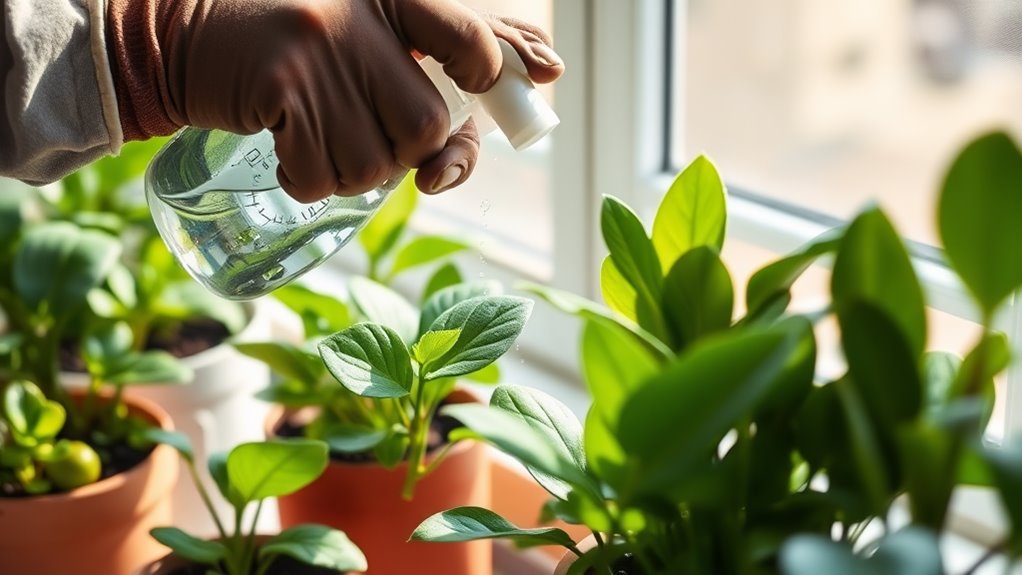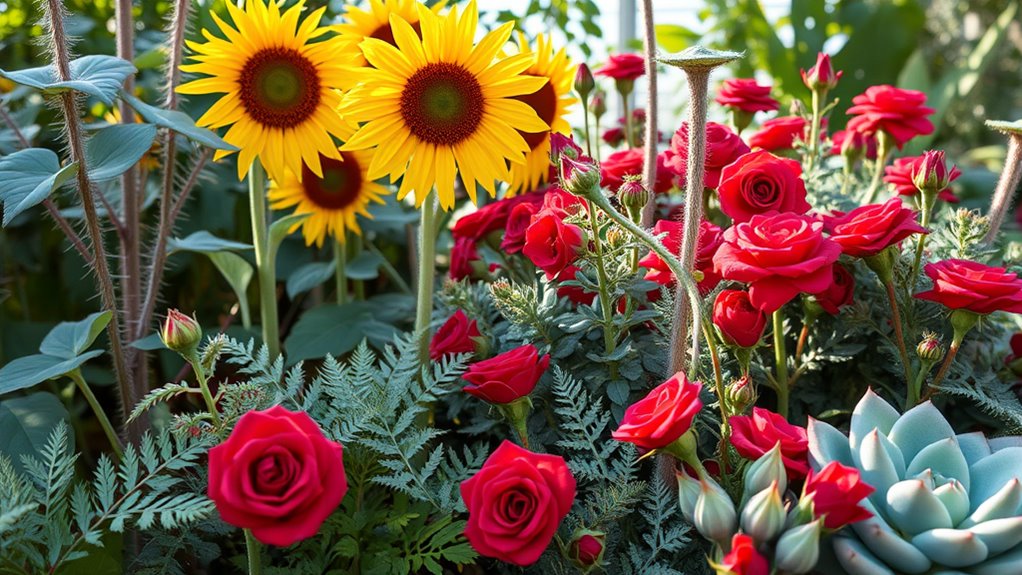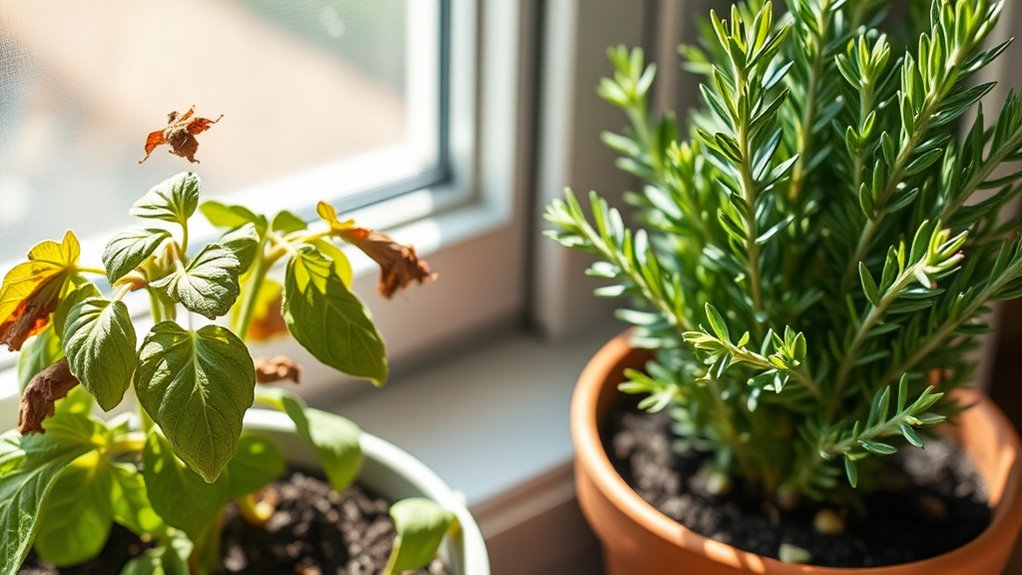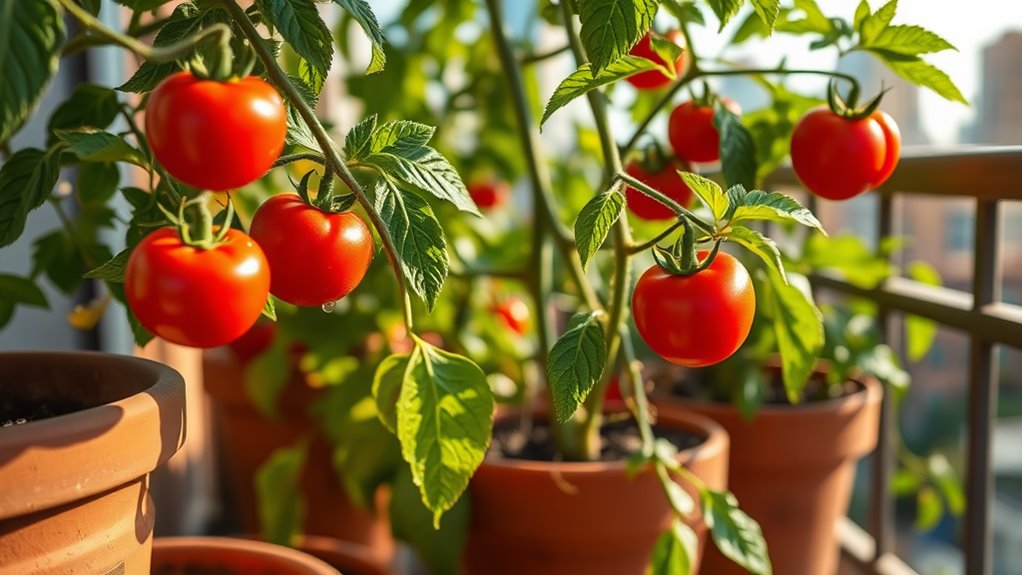My Easy Routine for Pest-Free Indoor Plants
You’ll easily keep your indoor plants pest-free by starting with daily checks for common pests like aphids or spider mites on leaves and stems, wiping them clean to remove dust. Use well-draining soil for consistent watering, repot annually, and apply natural remedies such as neem oil spray or insecticidal soap at the first sign of trouble. Perform weekly maintenance by pruning dead foliage and monitoring health closely. As you build this habit, you’ll uncover additional strategies to boost your plants’ resilience.
Key Takeaways
- Inspect plants daily for pests like aphids or spider mites to catch issues early.
- Wipe leaves weekly with a damp cloth to remove dust and prevent pest buildup.
- Use well-draining soil and water consistently to avoid overwatering and root issues.
- Apply neem oil spray on affected areas for a natural, effective pest remedy.
- Maintain a journal to track plant health and adjust routines based on observations.
Identifying Common Pests on Indoor Plants
When you spot tiny insects or unusual damage on your indoor plants, you’ll need to identify common pests like aphids, spider mites, or mealybugs quickly.
For effective indoor pest control, check leaves for aphids’ sticky honeydew, spider mites’ fine webbing, and mealybugs’ fluffy white clusters. Use a magnifying glass to spot these tiny invaders early; aphids often cluster on new growth, while spider mites cause stippled yellowing.
Mealybugs hide in leaf axils, leaving a waxy residue. Regular visual inspections help you distinguish pests from natural damage, ensuring precise indoor pest control without delay. To enhance your pest management, consider using natural staples like garlic or neem oil for additional protection.
Stay vigilant to maintain plant health.
Additionally, for a sustainable approach to pest management, consider using eco-friendly methods like introducing beneficial insects or homemade sprays.
Preventive Measures for Plant Health
You’ll keep your indoor plants thriving and pest-free by starting with routine inspections, where you check leaves, stems, and soil weekly for early signs of trouble.
This simple habit lets you catch potential issues before they escalate, saving you time and effort. To enhance your defenses, familiarize yourself with the top five pests that could impact your plants.
Don’t overlook soil care either; choose well-draining mixes and avoid overwatering to create an environment that’s less inviting to pests.
Furthermore, incorporating effective indoor pest control techniques can provide additional protection for your plants.
Routine Inspections
Regular routine inspections are essential for maintaining the health of your indoor plants and preventing pest infestations.
You’ll spot early signs of trouble, like pests or diseases, before they escalate, keeping your greenery vibrant and healthy.
-
Examine leaves weekly: Flip over leaves to check for tiny insects, webbing, or spots, using a magnifying glass if needed.
-
Inspect stems and nodes: Gently run your fingers along stems to feel for bumps, eggs, or unusual softness that might indicate pests.
-
Monitor overall plant vigor: Look for wilting, yellowing, or stunted growth, which could signal hidden issues, and isolate affected plants immediately.
-
Document your findings: Keep a simple log of inspections, noting any problems and actions taken to track patterns over time.
Soil Care
Proper soil care serves as your first line of defense against pests and diseases in indoor plants.
You can start by choosing a sterile, well-draining potting mix with perlite or vermiculite to prevent waterlogging, which attracts pests like fungus gnats.
Always sterilize new soil by baking it in the oven at 180°F for 30 minutes to eliminate hidden pathogens.
Monitor moisture levels regularly; water only when the top inch feels dry to avoid root rot.
Aerate the soil gently every few weeks to promote healthy roots, and repot annually with fresh mix to refresh nutrients and reduce pest buildup, ensuring your plants stay vigorous and pest-resistant.
Natural Remedies for Pest Control
When pests invade your indoor plants, natural remedies offer a safe and effective alternative to chemicals. You’ll protect your greenery while keeping your home eco-friendly.
These solutions target common pests like aphids and spider mites without synthetic risks. Additionally, these natural approaches utilize organic ingredients for enhanced effectiveness.
These natural approaches draw from unconventional remedies that effectively reclaim spaces without harsh chemicals.
-
Neem oil spray: Mix a few drops of neem oil with water and mild soap; spray directly on affected leaves to suffocate pests.
-
Insecticidal soap: Combine liquid soap with water; apply it weekly to disrupt pest cell membranes on your plants.
-
Diatomaceous earth: Dust this powder around plant bases; it dehydrates crawling insects on contact.
-
Garlic infusion: Blend garlic cloves with water, strain, and spray; its strong odor repels bugs naturally.
Daily and Weekly Maintenance Routines
To keep your indoor plants thriving and pest-free, you’ll want to adopt simple daily and weekly routines that blend inspection, cleaning, and care.
Every day, check leaves and stems for early pest signs like discoloration or webbing, then gently wipe them with a soft, damp cloth to remove dust and debris. Water consistently, ensuring soil stays moist but not soggy, and rotate plants for even light exposure. To further enhance pest control, consider using natural herbs that can deter common indoor pests.
Weekly, thoroughly clean pot surfaces and trays to prevent buildup, prune dead or yellowing foliage to encourage growth, and monitor soil moisture levels for optimal health.
These habits build resilience against pests.
For added defense against pests, consider incorporating organic pest sprays based on effective natural remedies tested in gardens.
Effective Treatment Techniques
If pests invade your indoor plants despite your best efforts, you’ll want to act fast with proven techniques that target the problem directly. These methods are straightforward and minimize damage while eliminating pests effectively. For an extra natural approach, consider creating a DIY pest spray using simple ingredients to enhance your pest control efforts.
-
Manually remove insects: Pick off visible pests like aphids or spider mites using a soft cloth or tweezers, then dispose of them to reduce populations immediately.
-
Apply insecticidal soap****: Mix a solution and spray it on affected areas to disrupt pests’ cell membranes; cover all surfaces and reapply after 7 days if needed.
-
Use neem oil****: Dilute this natural oil and coat leaves to repel and kill insects; apply in the evening to avoid sun damage and repeat every 5-7 days.
-
Introduce beneficial predators*: Release *ladybugs or predatory mites to naturally control aphids and other pests in a contained environment.
For additional inspiration, consider adapting cost-effective methods from natural gardening strategies to further protect your indoor plants.
Ongoing Monitoring and Adjustments
Once you’ve tackled pests with your chosen techniques, regularly check your plants to spot any new issues early.
Schedule weekly inspections, focusing on leaves, stems, and soil for signs like webbing, spots, or tiny insects such as aphids and mites. Use a magnifying glass for detailed views and note any changes in plant health, like yellowing or wilting.
If problems emerge, isolate affected plants and adjust your routine—tweak watering, boost humidity, or switch treatments based on observations. Additionally, ensure proper watering techniques to optimize hydration and reduce the risk of pest infestations.
Keep a simple journal to track trends, helping you refine strategies seasonally. This proactive vigilance ensures lasting pest control and vibrant growth.
To further support your indoor plants, integrate aspects like lighting from indoor gardening practices to enhance overall plant resilience and reduce pest vulnerabilities.





